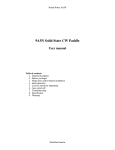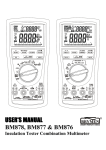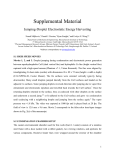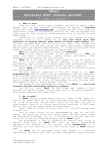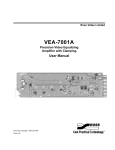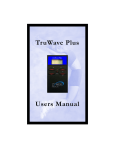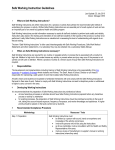Download User manual
Transcript
Nenad Rotter, 9A5N 9A5N Solid State CW Paddle User manual Table of contents: 1. General description 2. Before you begin 3. Finger piece and/or battery installation 4. Interconnection 5. Lever(s) sensitivity adjustment 6. Auto switch off 7. Contest mode 8. Troubleshooting 9. Transport 10. Specification 11. Warranty [email protected] Nenad Rotter, 9A5N 1. General description Thank you for purchasing the Solid State CW Paddle. It should provide many hours of CW keying pleasure for years to come. The Solid State CW Paddle is a very sensitive instrument, having no moving parts, which will give you a new sense of CW keying. Advantages of the Solid State CW Paddle: • stationary lever(s) having no travel time and no inertia of motion • necessary keying force on the lever(s) is reduced • finger movements are diminished • keying is absolutely silent, without the clicking sound so characteristic of mechanical paddles • the lack of mechanical contacts eliminates cleaning, adjustments and bouncing • lever sensitivity adjustment is done by a software algorithm and no tools are required • no maintenance The keying technique for the Solid State CW Paddle is equivalent to that required for mechanical paddles. Users will rapidly adjust their keying style to gain the advantages of the Solid State CW Paddle and increase their maximum keying speed with ease. Since less finger pressure is necessary on lever(s) and finger movements are diminished, keying will be less fatiguing and more enjoyable. The Solid State CW Paddle has two major parts: head and base. The paddle “brain” based on microcontroller technology is situated in the head, which is made of aluminum to protect sensitive electronic components from the effects of RF signals. The paddle base is a piece of stainless steel/coated steel with a mass of 1.5 kg. The total paddle mass of 1.8 kg gives outstanding paddle stability on flat surfaces during keying. In order to generate CW code, an external keyer or a transceiver with built-in keyer must be used. The Solid State CW Paddle is available in a single and twin lever version. ATTENTION: Avoid exposing the paddle lever(s) to any excessive pressure or shock. Excessive pressure can drastically reduce the lifetime of sensors internal to the lever(s) while stronger shocks can cause permanent damage. [email protected] Nenad Rotter, 9A5N 2. Before you begin The Solid State CW Paddle is delivered without batteries and an interconnection cable, mainly due to the paddle’s shipping weight. In order to keep the paddle as heavy as possible and still limit the mass to a maximum of 2 kg for delivery as a registered letter to your address, no batteries or cables are included in the package. In order to prepare the Solid State CW Paddle for operation, you will need to obtain the following: • battery AAA (LR03) type - 2 pcs • an interconnection cable The installation of the battery and interconnection is described below: The button on the right side of the paddle is the on / off switch. The paddle status is indicated by a blue LED behind a white window under the lever(s). The button acts as a toggle: To switch the paddle on, push the button until the LED turns on. To switch the paddle off, push the button until the LED turns off. The switch off action takes around 0.5 second to avoid involuntary paddle offs. Remember to retain your original Solid State CW Paddle box for future transport (e.g. portable operation, DX expeditions, etc.) and/or for secure paddle storage. 3. Finger piece and/or battery installation If your paddle is sent to you via post, the finger piece(s) are not mounted on the lever(s) to avoid lever sensor damage during shipment and batteries are not inserted due to postal service safety regulations. As finger piece montage on lever(s) and battery insertion can be done at the same time, the procedure below describes both. To reach the battery compartment it will be necessary to separate the paddle base and head, which are connected together with 4 screws. In addition, the installation of the finger piece(s) is safe and easy when the paddle base and head have been separated. For this task you will need: a Phillips screwdriver (a magnetic tip is recommended) and a book that is at least 5 mm thick. A hex key for finger piece screws is attached. Note that a finger piece, once attached, will be higher than the paddle head and that the paddle should not be placed upside down on a flat surface without using the book. ATTENTION: Always check the + or - direction of batteries before insertion, as batteries inserted with the wrong polarity will cause permanent damage to paddle electronics. Sensors on lever(s) are very sensitive to excessive pressure. Special care should be taken during finger piece screw tightening. [email protected] Nenad Rotter, 9A5N Procedure: 1. Place the book on the table. 2. Turn the paddle upside down and place the head on the book taking care that any installed finger pieces are free in the air. 3. Remove 4 screws. 4. Lift up the base. If you are only installing/replacing the batteries, continue with step 8. 5. Remove protective foil from finger piece if not removed already and insert screws into finger piece holes. For the twin lever version, take care to put each finger piece on the correct side. Screw heads should be on the side having rounded edges. 6. Align finger piece to lever so that screws can touch threads on lever. Take the hex key and turn one screw a little. Always turn gently and apply as little pressure on the lever as possible. When the first screw is halfway in, repeat with the second screw. Turn screws alternately until completely in but not yet tight. On the twin version, repeat for the second lever. 7. Check finger piece(s) and lever alignment(s) and tighten screws gently. On the twin version, also check the alignment of the two finger piece edges and then tighten screws gently on both finger pieces. [email protected] Nenad Rotter, 9A5N 8. Put batteries in holder, while taking care that the polarity is correct. 9. Press the on / off button and switch on paddle. If the paddle doesn’t switch on, rotate the batteries in the holder with your fingers and try again. 10. When the paddle switches on, press the button again and switch off paddle. 11. Place the base back on the head and align holes on the base with holes on the head. 12. Put screws one by one into the base holes and turn a little. If the screwdriver tip is magnetic this task will be very easy. 13. When all 4 screws are in place, screw them in completely and tighten gently. 14. Turn paddle over to its normal position. Battery lifetimes depend on quality and usage, but generally, should last for approximately 800 operating hours for the single version and 600 operating hours for the twin version. The paddle will still operate with very low battery voltage; as a result, batteries should be replaced to avoid acid leakage. The intensity of the blue LED light reflects the battery state. When weak or invisible it is time to change the batteries. ATTENTION: Never leave batteries in the paddle if stored long term. [email protected] Nenad Rotter, 9A5N 4. Interconnection On the back of the Solid State CW Paddle there is a 3.5 mm 3-pin (“stereo”) socket for connection with external devices (such as a keyer or transceiver with a built-in keyer). For interconnection between the Solid State CW Paddle and an external device, a two-wire shielded cable must be used. Users can easily make their own cable to the required length. To use, one cable end must go into the Solid State CW Paddle’s, 3.5 mm 3-pin (“stereo”) phone plug. The plug pin outs are: Tip – left lever, or left side of single lever, normally Dot out Ring – right lever, or right side of single lever, normally Dash out Shaft – common At the other cable end, the type of plug and pin outs depend on the device to be used. You may want to consult the device user manual for these details. In most cases (where the pin outs are the same on both the paddle and the external device) prefabricated shielded audio cable with a 3.5 mm stereo plug on both ends can be used. If the external device has a 6.3 mm paddle socket, a “stereo” adapter from 3.5 mm to 6.3 mm may be used. Some telegraphers may prefer to use a reversed Dot / Dash paddle configuration. If this is the case, the interconnection cable should be reversed at one end. It is also possible to use a straight cable with the external device set to a reversed paddle configuration. The Solid State CW Paddle outputs are of semiconductor type. Outputs will work properly if a positive voltage to common is present on the Dot and Dash line. Most electronic keyers and transceivers have +5 V present on Dot / Dash input lines while the current to common is 1 mA or less. Paddle outputs can handle voltages up to 50 V and current up to 10 mA. [email protected] Nenad Rotter, 9A5N 5. Lever sensitivity adjustment The only thing that users can adjust on the Solid State CW Paddle is lever sensitivity to the finger pressure required to close paddle outputs. When sensitivity is higher, a lower finger pressure is required on the lever to close paddle outputs and vice versa, when sensitivity is lower, a higher finger pressure is required on the lever to close paddle outputs. The sensitivity of lever sides in the single version or levers in twin version are always equal and cannot be changed separately. The Solid State CW Paddle has been delivered preset to the highest lever sensitivity. This may be too high for some users, especially when beginning paddle use and such users may want to reduce it. Sensitivity can be adjusted in a range from 10 grams to 50 grams approximately, in 8 steps - with 5 grams to each step. Correct lever sensitivity is very important for correct CW keying and every user should select the sensitivity that is most suitable for him/her. The Solid State CW Paddle lever sensitivity adjustment is done by a software algorithm and requires no other tools. Lever sensitivity can be changed at any time, taking just a few seconds. When the software algorithm for lever sensitivity adjustment has been activated, the paddle outputs become temporarily inactive. The lever(s) and LED function allow changes to sensitivity with the following functions: • a short push to the right side of the lever (or the right lever) will decrease the sensitivity by one step and the LED will confirm the lever push with a long blink • a short push to left side of the lever (or the left lever) will increase the sensitivity by one step while the LED will confirm the lever push with a short blink • three short LED blinks after a lever push indicates that the high or low sensitivity limit has been reached To start the software algorithm for lever sensitivity adjustment, perform the following procedure: 1. 2. 3. 4. 5. Switch on paddle if it is not already on Push the on / off button and keep it pushed in The LED will turn off and 2 seconds later, will briefly blink 3 times Release the on / off button The LED will blink again. The paddle is now in sensitivity adjustment mode. At this point you will be able to change the sensitivity with pushes to the lever(s) as described by the functions above. Count the LED confirmation blinks. This number will give you information on the extent to which you have changed the sensitivity. If you want to change the sensitivity rapidly, push the desired side of the lever (or the desired lever) and keep it pressed. The sensitivity will then change at a rate of 1 step per second. Count the LED confirmation blinks, as that tells you by how much the sensitivity has changed. When the sensitivity has been changed by the required numbers of steps to a new value, the paddle should be turned back to normal operational mode, to check the new lever sensitivity. [email protected] Nenad Rotter, 9A5N To stop the software algorithm for lever sensitivity adjustment, push the on / off button until the LED turns on, which indicates normal paddle mode operation. You can then check the new lever sensitivity. If the required sensitivity has not been achieved, repeat the adjustment procedure as many times as necessary. The value of the lever(s) sensitivity is permanently saved in the microprocessor's EEPROM and will not change until adjusted again. 6. Auto switch off If no paddle lever is pressed for approximately 40 minutes, the Solid State CW Paddle will switch off automatically. 7. Contest mode (S/N: MMXIV 052 and up) During CW contests, paddles are used infrequently, but should be permanently ready 24/48 h to commence immediate keying. As paddles may also be unused for periods longer than 40 minutes, the Auto switch off function should be temporarily disabled. Procedure: 1. Switch off paddle if it is not already off 2. Push the on / off button and keep it pushed 3. The LED will turn on start blinking 2 seconds later 4. Release the on / off button 5. The LED will turn on and stay on. This indicates that the paddle is in contest mode and will remain so unless the user switches it off manually. Contest mode is canceled when the paddle is switched off. ATTENTION: Do not forget to switch off paddle manually after entering contest mode, because otherwise the paddle will remain on until the batteries have discharged completely. 8. Troubleshooting If the Solid State CW Paddle starts to key out Dots or Dashes by itself, simply switch it off and on. If you experience some other kind of malfunction, please report it to the manufacturer. ATTENTION: The Solid State CW Paddle may work improperly if a very strong RF field is present in the ham shack. [email protected] Nenad Rotter, 9A5N 9. Transport Do paddle transport in original paddle box, always. ATTENTION: It is highly recommended to dismantle finger piece from lever(s) before transport to avoid possible lever sensors damage in case of rough handling with the box. Never leave batteries in the paddle if sending by the post. 10. Specification Dimensions: Base material: Head material: Finger piece material: Total weight: Lever sensitivity: Paddle outputs: Supply: Batteries lifetime: Sensors lifetime: 90 x 90 x 60 mm stainless steel/coated steel anodized aluminum Plexiglas, other materials on request 1.8 kg adjustable in range from 10 g to 50 g 50 V / 10 mA max. 2 x AAA (LR03) batteries Single version – 800 h Twin version – 600 h depending on battery quality 100 million pushes, approximately 11. Warranty The warranty period for the Solid State CW Paddle is 24 months from date of purchase and covers defects in material or workmanship, with the exception of lever sensors. Mechanical damage to the paddle, or failure in paddle electronics as a result of battery insertion with the wrong polarity, will invalidate the warranty. [email protected]









